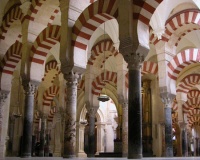Mosque-Cathedral of Cordoba (780 AD)
The Architectural Coexistence Between Different Religions[edit]
The Mesquita de Córdoba, or The Mosque-Cathedral of Córdoba, was once the greatest centre of worship in the westernmost Islamic state in the world, and is situated in a city that witnessed the dawn of Western civilization. It is a spiritual sanctuary, a holy place; truly unique in the world. Throughout its history, the Mezquita de Córdoba has oscillated between functioning as a Cathedral and a Mosque. Built initially by the Visigoths as a Catholic Christian church dedicated to Saint Vincent, the building was latterly divided between Christians and Muslims following the Islamic conquest of the Visigothic kingdom in the 8th century. The city of Córdoba was thus transformed from bustling Roman metropolis to jewel in the crown of Arabic Andalucía, and within the halls of the Mezquita aspects of religion, philosophy, anatomy, geometry, and countless other intellectual disciplines were weighed and considered, forming part of a cultural melting pot that would go on to greatly influence Western thinking and culture. After the reconquista, it was converted once more into a Catholic church. The Mezquita represents a fine example of where these disparate cultures intersected; not only living side by side, but profoundly influencing one another in terms of architecture and spirituality. In the modern era, however, Muslims are prevented from praying in the complex, and as such the Islamic Council of Spain lodged a formal request with the Vatican, a move that has been opposed by the Vatican and Spanish church authorities. The cathedral is regarded as one of the most accomplished monuments of Moorish architecture.
